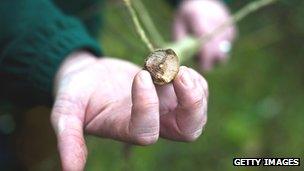Ash fungus genetic data released
- Published

Chalara dieback of ash is caused by the Chalara fraxinea fungus
The first genetic data on the fungus afflicting British ash trees has been released on the web by UK scientists.
Part of the RNA of the fungus has been sequenced, revealing information about how the disease spreads.
Researchers at The Sainsbury Laboratory and the John Innes Centre want international researchers to help analyse the preliminary data.
The long term goal is to find out how the Chalara fungus causes ash dieback and where in the world it originated.
Professor Sophien Kamoun, head of the Sainsbury Laboratory, said the tiny amount of data generated so far - in a matter of weeks - is already giving interesting insights.
Rather than keeping the data to themselves, the experts have released it on the web so that others can start analysing it immediately.
A similar approach was taken in last year's E coli outbreak in Germany, enabling researchers to track the source and spread of the infection.
"This is the first insight into the genetics of this fungus," Prof Kamoun told BBC News. "It's not the complete picture yet."
First step
The RNA was extracted from the twig of a diseased tree in Ashwellthorpe wood in Norfolk. Experts sequenced the RNA of the fungus, which was mixed up with that of the plant.
Other scientists can now use existing databases to sort out the information, and look at the genes involved in the spread of the fungus.
Professor Michael Shaw, a plant health expert at the University of Reading, who was not involved in the research, said it was a step towards understanding why certain strains of the fungus cause disease while others are benign.
"It's a step towards understanding the mechanism by which the fungus produces the disease and why this fungus is different from the one that lives in ash naturally in this country, which is closely related," he said.
Dr John Morgan, head of the Forestry Commission's plant health service, said the work would help shed light on "the history and nature of the introduction of new pests like Chalara, and in helping to understand how we tackle the disease that's arrived and to understand what the risk of spreading is".
UK spread
Chalara dieback of ash is caused by the Chalara fraxinea fungus.
The disease was first observed as a new form of ash dieback in Poland in 1992, and has since spread to ash trees in many European countries.
Ash dieback was first confirmed in the UK in ash plants in a nursery in England in February 2012.
Cases have since been confirmed across England, Wales, Scotland and Northern Ireland.
- Published12 December 2012
- Published6 November 2012